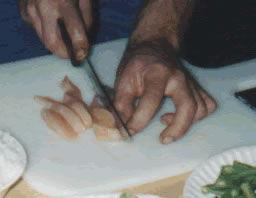Getting Started
 The
most important part of cooking Chinese food at home is work area and ingredient
preparation. The
most important part of cooking Chinese food at home is work area and ingredient
preparation.
Because stir-frying is so quick, you should
have all your chopping and sauce preparation ready before you turn on
the stove. Once you start stir-frying, you won't have the time to do anything
but stir-fry!
FOOD SAFETY:
| • |
WASH HANDS & WORK AREA (Kids
sometimes needs to be reminded) |
| • |
Designate different cutting boards for
raw meat and veggies for food safety's sake. |
| • |
Thaw frozen meats in the fridge (bottom
shelf) or microwave (finish cooking immediately after micro-thawing)
- NOT on the counter. |
| • |
Use separate clean plate for cooked
meat, not the same platter that held raw items. |
FOOD PREPARATION:
Meat Cutting Techniques
 Chill
meat in the freezer for an hour, until very firm and slightly icy. Using
a sharp knife, cut across the grain, making slices at a slight angle "about
1/4-inch thick". Chill
meat in the freezer for an hour, until very firm and slightly icy. Using
a sharp knife, cut across the grain, making slices at a slight angle "about
1/4-inch thick".
Vegetables Cutting
Techniques
Crushing, Smashing:
Crushing or smashing garlic, ginger or shallots releases the flavor of
these ingredients into your dishes. It also loosens the skin so that peeling
is made easier, subsequently cutting down on preparation time. To crush
or smash, bring the side of the cleaver (or a very heavy, thick-bladed
knife) down onto the food in a slapping motion, decisively striking it.
If you find that the slapping motion is not comfortable for you, simply
place the cleaver onto the food and strike it firmly with your fist. You
are then ready to peel or chop.
Slicing:
Using your knuckles to hold down the food, and as a guide for the blade,
hold the knife or cleaver perpendicular to the cutting surface and cut
straight through the food, down and away from your body.
Shredding:
Cut food into 2-1/2" pieces, then cut those pieces into thin slices.
Stack the slices and cut them lengthwise once again into very thin strips.
Dicing:
Follow the steps for shredding, then line the shreds up and cut them
crosswise. Depending upon the size of the shredded or sliced vegetables
you desire, you may slice your pieces more thinly or thickly in any of
the above steps.
Mincing:
Mincing simply takes dicing a step further. Follow the steps for dicing
above, then continue to finely chop; the result will be a minced vegetable.
Slant Cutting:
A slant cut may be used to dress up your dishes, particularly when slicing
long, thin vegetables like carrots, asparagus, zucchini, turnips, string
beans or Chinese radishes, or thin pieces of meat. Slant cutting creates
larger pieces of food which will cook more quickly because a larger surface
area is exposed to cooking heat. It also enables the food's juices to
be incorporated more willingly into the sauce. To slant cut, simply hold
the meat or vegetables from the side, again using your knuckles as a guide,
and cut at a 60-degree angle.
|